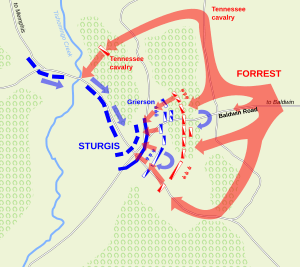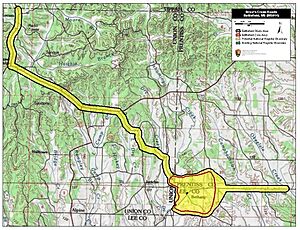Battle of Brice's Cross Roads facts for kids
Quick facts for kids Battle of Brice's Cross Roads |
|||||||
|---|---|---|---|---|---|---|---|
| Part of the Western Theater of the American Civil War | |||||||
 The Battle of Brice's Cross Roads, June 10, 1864 |
|||||||
|
|||||||
| Belligerents | |||||||
| Commanders and leaders | |||||||
| Strength | |||||||
| 3,500 cavalry | 4,800 infantry 3,300 cavalry 22 guns |
||||||
| Casualties and losses | |||||||
| 96 killed 396 wounded |
223 killed 394 wounded 1,632 missing/captured 16 guns |
||||||
The Battle of Brice's Cross Roads was a major fight during the American Civil War. It is also known as the Battle of Tishomingo Creek or the Battle of Guntown. It happened on Friday, June 10, 1864, near Baldwyn, Mississippi. This area was then part of the Confederate States of America.
A Union (Federal) army from Memphis, Tennessee, had about 4,800 foot soldiers and 3,300 cavalry (soldiers on horseback). This force was led by Brigadier-General Samuel D. Sturgis. They were defeated by a smaller Confederate force of 3,500 cavalry. The Confederate soldiers were led by Major-General Nathan Bedford Forrest. The battle was a big victory for the Confederates. Forrest's troops caused many losses for the Union army. They also captured over 1,600 Union soldiers, 18 cannons, and many wagons full of supplies. After this defeat, General Sturgis asked to be removed from his command.
Contents
Why the Battle Happened
In March 1864, Ulysses S. Grant became the main general for the Union army. He and his trusted helper, Major-General William Tecumseh Sherman, planned a new way to win the war. Grant would fight General Robert E. Lee's army in Virginia. At the same time, Sherman would attack the other main Confederate army. He would also try to capture Atlanta, a very important city.
Atlanta's Importance
Atlanta was called the "Gate City of the South." It was a key city for the Confederates. It had many factories that made weapons, second only to Richmond, Virginia. Atlanta was also a major transportation hub. Four railroads met there, carrying supplies to Confederate soldiers. Sherman's goal was to cut off these supplies and weaken the South.
Getting Ready for Battle
Sherman started his Atlanta Campaign in early May. He moved slowly south, fighting Confederate forces led by General Joseph E. Johnston. Johnston was very good at defending his positions. He called for more soldiers, including some from Lieutenant-General Leonidas Polk's army. This left Major-General Stephen D. Lee in charge of other Confederate forces in the area. Lee wisely let General Forrest act on his own in northern Mississippi and Tennessee.
Sherman's Concerns
As Sherman's campaign continued, his supply lines became very long. These lines stretched all the way back to Nashville, Tennessee. Sherman worried that General Forrest might move his cavalry (horse soldiers) into Middle Tennessee. If Forrest attacked the supply lines, it could put the whole Union effort in danger.
So, in late May, Sherman ordered General Sturgis to leave Memphis. Sturgis was to go into North Mississippi with over 8,000 men. His mission was to keep Forrest busy. If possible, he was to destroy Forrest's Confederate cavalry. Sherman's orders came just in time. Forrest's cavalry had just left for Middle Tennessee. They had to turn back to Mississippi to defend the state. Sturgis's Union force marched out of Memphis on June 1. He was told to go to Corinth, Mississippi, and then south. His orders included destroying parts of the Mobile and Ohio Railroad.
The Battle Begins
On June 10, at 9:45 a.m., Union cavalry reached Brice's Cross Roads. The battle started at 10:30 a.m. The Confederates began by slowing down the Union advance. General Forrest ordered the rest of his cavalry to gather around the cross roads. More Union cavalry arrived to help, but a strong Confederate attack pushed them back at 11:30 a.m. This happened when more of Forrest's cavalry arrived.
Fierce Fighting
The Union cavalry leader, General Benjamin Grierson, asked for foot soldier support. General Sturgis sent them. The Union line held until 1:30 p.m., when the first Union foot soldiers arrived. These new soldiers helped the Union line. They even attacked the Confederate left side. But Forrest then attacked from both his far right and left sides. He did this before all the Union foot soldiers could get into position.
During this part of the battle, Forrest ordered his cannons to fire very close to the Union line. They used canister shot, which was like a giant shotgun blast. This caused huge damage to the Union troops. Sturgis had to pull his line back into a tighter circle around Brice's Cross Roads.
Union Retreat
At 3:30 p.m., Forrest's 2nd Tennessee Cavalry attacked a bridge across the Tishomingo Creek. This attack failed, but it confused the Union troops. Sturgis then ordered a general retreat. As the Tennesseans kept pushing, the retreat became jammed at the Tishomingo bridge. The Union soldiers panicked and ran away. Sturgis's forces fled wildly back towards Memphis. Confederate attackers chased them across six counties. Finally, the exhausted Confederates stopped their pursuit.
After the Battle
After the battle, Colonel Alex Wilkin, a Union commander, wrote about why they lost. He said that General Sturgis knew his men did not have enough supplies. They had been on very little food. Sturgis did not want to attack, but he was ordered to. When the cavalry fought, many foot soldiers were told to run fast to support them. Because they were weak, many fell behind. Those who arrived were very tired. The Confederates, however, were fresh and well-fed.
Difficult Conditions
The roads to Tupelo were wet and muddy from six days of rain. This made it hard for supply wagons and ammunition carts to move. Many men had to work to make the roads passable. Also, the horses pulling the wagons were not well-fed. There was little food for them along the way. This is why General Forrest was able to capture so many cannons and supplies.
The Confederates also had better information. Civilians in the area constantly told them where the Union soldiers were and how strong they were. General Sturgis did not get this kind of information. Because of this, Forrest planned to meet the Union army where he could surprise them. He also made sure it would be hard for them to retreat. This spot was close to his supplies and far from the Union army's. When the Union soldiers retreated, many could not keep up because they were tired and had no food. This is why so many Union soldiers were captured.
Battlefield Preservation
The Brices Cross Roads National Battlefield Site was created in 1929. It remembers the Battle of Brice's Cross Roads. Many people think it is one of the best-preserved Civil War battlefields. The National Park Service has put up monuments and signs on a small piece of land at the cross roads.
In 1994, people who cared about the battlefield formed a group. It is called the Brice's Cross Roads National Battlefield Commission, Inc. Their goal is to protect more of the battlefield land. With help from groups like the Civil War Trust, they have bought over 1,420 acres (about 5.7 square kilometers) of land to preserve it. Much of this land was bought from the Agnew Family, who still own some property there.
The modern Bethany Presbyterian Church is near the cross roads. At the time of the battle, their church building was further south. Bethany Cemetery is next to the National Park Service monument. It was there before the Civil War. Many early settlers are buried there. The graves of over 90 Confederate soldiers killed in the battle are also in Bethany Cemetery. Union soldiers were first buried in shared graves. Later, they were moved to the Memphis National Cemetery.
The American Battlefield Trust and its partners have been buying and preserving land at Brice's Cross Roads since 1996. By late 2021, they had acquired and preserved 1,500 acres (about 6 square kilometers). This is almost the entire battlefield.
Images for kids





